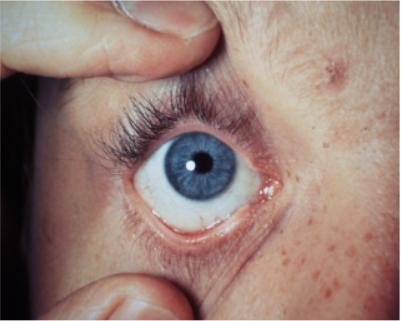|
Inspection of eyelids,
conjunctiva and sclera:
-
Observe eyelids for
redness, swelling, and lesion’s.
-
Inflammation of an eyelash
follicle with a lump, called a sty or hordeolum, is usually caused
by staph.
-
Check the position of the
upper lid — it should cover the top part of the iris only but not
the pupil.
-
Ptosis is present when the
upper eyelid droops over the pupil.
-
Check the conjunctiva and
sclera for redness color or discharge. A yellow sclera indicates
jaundice.
-
Ask the patient to look up
as you depress both lower lids with your thumb exposing the sclera
and conjunctiva.
-
A special exam is done if
you suspect a foreign body — eversion of the upper eyelid. Ask the
patient to look down, pull downward and forward on the eyelashes.
Place a "Q" tip 1 cm above the lid margin and push down on the upper
lid everting it. Alternatively, a bent paperclip can be used.
Pupils — Inspect the
size and equality of pupils. Test the pupillary response to light —
shine light obliquely into each eye. Look for:
Extra ocular Eye Muscles:
Ask patient to watch your finger as you move it in six directions
(think of a capital H) Watch for Nystagmus — the involuntary rhythmic
rapid movement of the eye.
This video was produced by the
Brookside Associates in 2008 to assist in orienting nursing students
to this procedure.
The video may be freely
downloaded.
|
Test visual acuity —Snellen
chart at 20 feet is the best screening method.
-
"Cover one eye and read the
smallest line possible".
-
Visual acuity is expressed
as two number 20/30.
-
The first number is the
distance in feet from chart, the second the distance at which a
normal eye can read the line of letters.
-
Vision of 20/200 means that
the patient can read print at 20 feet that a person with normal
vision could read at 200 feet.
-
You can test visual acuity
with any available print.

Text from Operational Medicine 2001
|

